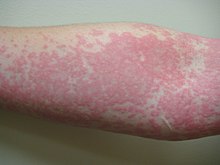| Hives | |
|---|---|
| Other names | Urticaria |
 | |
| Hives on the arm | |
| Specialty | Dermatology, Clinical immunology, Allergology |
| Symptoms | Red, raised, itchy bumps[1] |
| Duration | A few days[1] |
| Causes | Stress, following an infection, result, of an allergic reaction[2] |
| Risk factors | Hay fever, asthma[3] |
| Diagnostic method | Based on symptoms, patch testing[2] |
| Treatment | Antihistamines, corticosteroids, leukotriene inhibitors[2] |
| Frequency | ~20%[2] |
Hives, also known as urticaria, is a kind of skin rash with red and/or flesh-colored, raised, itchy bumps.[1] Hives may burn or sting.[2] The patches of rash may appear on different body parts,[2] with variable duration from minutes to days, and does not leave any long-lasting skin change.[2] Fewer than 5% of cases last for more than six weeks (a condition known as chronic urticaria).[2] The condition frequently recurs.[2][4]
Hives frequently occur following an infection or as a result of an allergic reaction such as to medication, insect bites, or food.[2] Psychological stress, cold temperature, or vibration may also be a trigger.[1][2] In half of cases the cause remains unknown.[2] Risk factors include having conditions such as hay fever or asthma.[3] Diagnosis is typically based on appearance.[2] Patch testing may be useful to determine the allergy.[2]
Prevention is by avoiding whatever it is that causes the condition.[2] Treatment is typically with antihistamines, with the second generation antihistamines such as fexofenadine, loratadine and cetirizine being preferred due to less risk of sedation and cognitive impairment.[4] In refractory cases, corticosteroids or leukotriene inhibitors may also be used.[2] Keeping the environmental temperature cool is also useful.[2] For cases that last more than six weeks long term antihistamine therapy is indicated. Immunosuppressants such as omalizumab or cyclosporin may also be used.[4]
About 20% of people are affected at some point in their lives.[2] Cases of short duration occur equally in males and females while cases of long duration are more common in females.[5] Cases of short duration are more common among children while cases of long duration are more common among those who are middle aged.[5] Hives have been described at least since the time of Hippocrates.[5] The term urticaria is from the Latin urtica meaning "nettle".[6]
- ^ a b c d "Hives". Archived from the original on 19 August 2016. Retrieved 10 August 2016.
- ^ a b c d e f g h i j k l m n o p q r Jafilan, L; James, C (December 2015). "Urticaria and Allergy-Mediated Conditions". Primary Care. 42 (4): 473–83. doi:10.1016/j.pop.2015.08.002. PMID 26612369.
- ^ a b Zuberbier, Torsten; Grattan, Clive; Maurer, Marcus (2010). Urticaria and Angioedema. Springer Science & Business Media. p. 38. ISBN 9783540790488. Archived from the original on 2016-08-21.
- ^ a b c Lang, David M. (1 September 2022). "Chronic Urticaria". New England Journal of Medicine. 387 (9): 824–831. doi:10.1056/NEJMra2120166. PMID 36053507. S2CID 251992431.
- ^ a b c Griffiths, Christopher; Barker, Jonathan; Bleiker, Tanya; Chalmers, Robert; Creamer, Daniel (2016). Rook's Textbook of Dermatology, 4 Volume Set (9 ed.). John Wiley & Sons. p. Chapter 42.3. ISBN 9781118441176.
- ^ A Dictionary of Entomology. CABI. 2011. p. 1430. ISBN 9781845935429. Archived from the original on 2016-08-21.